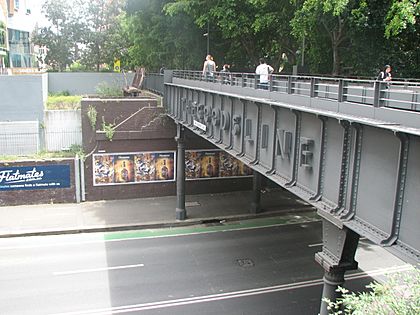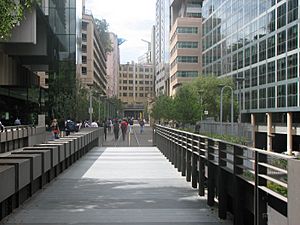Ultimo Road railway underbridge facts for kids
Quick facts for kids Ultimo Road railway underbridge |
|
|---|---|

Ultimo Road railway underbridge
|
|
| Coordinates | 33°52′52″S 151°12′06″E / 33.8812°S 151.2018°E |
| Carries |
|
| Crosses | Ultimo Road |
| Locale | Ultimo, City of Sydney, New South Wales, Australia |
| Owner | RailCorp |
| Characteristics | |
| Design | Girder bridge |
| Material | Wrought iron |
| Pier construction | Cast iron |
| Total length | 21.64 metres (71 ft) |
| Longest span | 13.72 metres (45 ft) |
| Number of spans | 3 |
| Clearance below | 4.4 metres (14 ft) |
| History | |
| Engineering design by | New South Wales Government Railways |
| Constructed by | NSW Public Works Department |
| Construction end | 1879 |
| Closed |
|
| Official name: Ultimo Road Railway Underbridge | |
| Type: | State heritage (built) |
| Designated: | 2 April 1999 |
| Reference #: | 1062 |
| Type: | Railway Bridge/ Viaduct |
| Category: | Transport - Rail |
The Ultimo Road railway underbridge is a special old bridge in Ultimo, a suburb of Sydney, Australia. It used to carry trains on the Darling Harbour goods railway line. This bridge was built in 1879 by engineers from the New South Wales Public Works Department.
Today, the bridge is no longer used for trains. Instead, it is part of The Goods Line. This is a popular walking path that connects Central station to the area near Sussex and Hay Streets in Sydney. The bridge is important because it is listed on the New South Wales State Heritage Register. This means it is a protected historical site.
Contents
How This Bridge Came to Be
The first railway line to the Darling Harbour area was finished in 1855. It went under George Street through a tunnel. This original line crossed Ultimo Road using a simple timber (wooden) bridge.
By the 1870s, many more goods trains were using the line. So, plans were made to add a second track. In 1879, the old timber bridge was replaced with a much stronger one made of wrought iron. This new bridge was designed by engineers from the Public Works Department.
The design of this new bridge was a bit unusual. Most double-track bridges have two main beams on the outside. But this bridge had an extra main beam in the middle, between the two tracks. This made it look like two single-track bridges joined together. It is called a "triple-girder" bridge.
However, trains kept getting heavier over time. The bridge's design wasn't strong enough for these new, heavier trains. Instead of building a whole new bridge, engineers added strong cast-iron columns around 1900. These columns were placed on the edges of Ultimo Road. This change helped the bridge support the heavier loads.
The railway line continued to be important for Darling Harbour. But new railway lines were built later, reducing the traffic on this old line. In the 1990s, the Darling Harbour goods yard closed down. The bridge stopped carrying regular train traffic around 1996. By 2005, it was fully closed to all trains. That's when it began its new life as part of The Goods Line walkway.
What the Bridge Looks Like

The Ultimo Road underbridge, built in 1879, is made of strong materials. It has cast-iron columns that hold up large wrought iron beams. These beams are called "plate web girders" and "cross beams." The bridge is designed as a "half-through" bridge. This means the train tracks (now the walking path) are placed between the main beams.
As mentioned, it's a "triple-girder" bridge. The middle beam is located right between where the two train tracks used to be. On both the north and south sides of Ultimo Road, there are brick supports called "abutments." These help hold the bridge up.
Originally, the bridge was one long span, about 21.64 metres (71 ft) long. But when the cast-iron columns were added around 1900, it changed. Now, it has three shorter spans. There's a span of 3.96 metres (13 ft) over each footpath. The main span in the middle is 13.72 metres (45 ft) long.
How the Bridge Is Doing Now
The Ultimo Road underbridge is in good shape for its age. You might see some rust on the tops of the columns and on the beams underneath. The old train tracks and the surface where trains ran are now covered. They have steel plates over them, which are a bit rusty in some spots. You might also see some graffiti on the side beams.
In 2010, experts checked the bridge to see if it could be used by people walking and cycling. They decided it could! But they recommended replacing the old deck with a lighter one. They also suggested adding safety screens to stop things from falling onto the road below. The high-voltage cables also needed better protection for public access.
Most of the original parts from 1879 are still there. This includes the cast-iron columns added around 1900. These columns changed the bridge from one long span to three shorter ones.
Changes Over Time
- c. 1900: Cast-iron columns were added. This made the bridge stronger for heavier trains. It changed from one long span to three shorter ones.
- c. 1996: The bridge stopped being used for regular train traffic.
- 2005: Steel plates were put over the old tracks and surface. This happened when the bridge was fully closed to all trains and turned into a walking path.
Why This Bridge Is Special
The Ultimo Road underbridge is very important to the history of New South Wales. It's considered a "heritage-listed" site. This means it's protected because of its historical value.
Here's why it's so special:
- It's the oldest remaining bridge of its kind made of wrought iron in the NSW railway system.
- It's a rare example of a "triple-girder, plate-web girder bridge."
- It's a physical reminder of the very first railway lines built in NSW.
- The changes made to the bridge in 1900 show how engineers adapted to bigger and heavier trains.
The bridge is also important because:
- It was a key part of the Darling Harbour railway area for over 120 years.
- It represents a time when railway bridges changed from timber to stronger iron.
- It's a unique and interesting landmark across Ultimo Road. The cast-iron columns have nice decorative details.
- It's a great example of early railway engineering. It's the oldest "plate-web girder" bridge in the NSW railway system.
- It's believed to be the only surviving wrought iron "triple-girder" bridge in the NSW railway system. This makes it very rare.

